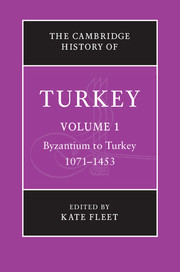Book contents
- Frontmatter
- 1 Introduction
- 2 The Byzantine Empire from the eleventh to the fifteenth century
- 3 Anatolia under the Mongols
- 4 Anatolia, 1300–1451
- 5 The incorporation of the Balkans into the Ottoman Empire, 1353–1453
- 6 Ottoman warfare, 1300–1453
- 7 The Turkish economy, 1071–1453
- 8 Art and architecture, 1300–1453
- 9 Social, cultural and intellectual life, 1071–1453
- Glossary
- Bibliography
- Index
- References
7 - The Turkish economy, 1071–1453
Published online by Cambridge University Press: 28 March 2010
- Frontmatter
- 1 Introduction
- 2 The Byzantine Empire from the eleventh to the fifteenth century
- 3 Anatolia under the Mongols
- 4 Anatolia, 1300–1451
- 5 The incorporation of the Balkans into the Ottoman Empire, 1353–1453
- 6 Ottoman warfare, 1300–1453
- 7 The Turkish economy, 1071–1453
- 8 Art and architecture, 1300–1453
- 9 Social, cultural and intellectual life, 1071–1453
- Glossary
- Bibliography
- Index
- References
Summary
It has been an often accepted axiom that Turks and economy were not good bedfellows. Presaged by the clouds of an army on the march, the arrival of the Turk was synonymous with economic disaster. For many historians of the nineteenth century, the imprint of the Turkish horse left eternal destruction and economic ruin. Even if modified and toned down in the later twentieth century, this view of the Turk as an economically destructive presence has, like the Turk's horse, left its mark on thinking about the Ottomans and has coloured much scholarship on the empire.
While later historians regarded the Turks as lacking economic motivation or acumen, contemporary Byzantines did not. Indeed, for Doukas, a well-informed observer of the Turks who knew Turkish and who worked for the Genoese, first in New Phokaea and then in Lesbos, the Turkish ‘nation’ was ‘a lover of money’. Writing much earlier, Kinnamos, too, noted the Turks' concern with financial matters, commenting that nothing distressed them more than economic loss. The Genoese, those quintessential merchants and entrepreneurs, likewise viewed the Ottomans not as mere military men but as economic partners. It was to money and his constant use of it that the Ottoman sultan Mehmed II owed his ascendancy in the estimation of the Genoese merchant Iacopo de Promontorio, active for many years in Ottoman territory during the reigns of both Mehmed and his father Murad II.
- Type
- Chapter
- Information
- The Cambridge History of Turkey , pp. 227 - 265Publisher: Cambridge University PressPrint publication year: 2009
References
- 2
- Cited by



